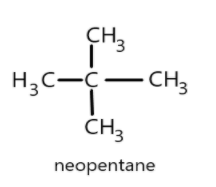
The minimum number of carbon atoms in an alkane having four primary carbon atoms are:
(1)
(2)
(3)
(4)
Answer
494.7k+ views
Hint: As we know that a primary carbon atom is the one which is bound to only one other carbon atom and in case of alkane, a primary carbon is bound with three hydrogen atoms and results in making of an acyclic structure.
Complete Step by step answer:
- A primary carbon atom is the one which is bound to only one other carbon atom and in case of alkane, a primary carbon is bound with three hydrogen atoms and results in making of an acyclic structure and not a ring structure. We can easily identify a primary, secondary or tertiary carbon in a compound by just counting the number of carbons attached to the main carbon or one at least one carbon.
- Primary carbon is attached with one other carbon, a secondary carbon is the one attached to the two other carbons and a tertiary carbon is the one attached to the three other carbon atoms and a quaternary carbon has four carbons attached to one carbon. For instance, ethane with one simple primary carbon, propane with two carbons attached to one primary carbon etc .
- Similarly in the given question the alkane having four primary carbon atoms can be a neopentane where the main chain is having three carbon atoms and two methyl groups attached to central carbon atom and the structure can be given as follows:

Neopentane has the simplest structure and the primary carbon has five carbon atoms each attached with three hydrogen atoms giving a molecular formula as
Therefore the correct answer is (3).
Note: Neopentane is a flammable gas substance at room temperature and pressure with a boiling point of only
Complete Step by step answer:
- A primary carbon atom is the one which is bound to only one other carbon atom and in case of alkane, a primary carbon is bound with three hydrogen atoms and results in making of an acyclic structure and not a ring structure. We can easily identify a primary, secondary or tertiary carbon in a compound by just counting the number of carbons attached to the main carbon or one at least one carbon.
- Primary carbon is attached with one other carbon, a secondary carbon is the one attached to the two other carbons and a tertiary carbon is the one attached to the three other carbon atoms and a quaternary carbon has four carbons attached to one carbon. For instance, ethane with one simple primary carbon, propane with two carbons attached to one primary carbon etc .
- Similarly in the given question the alkane having four primary carbon atoms can be a neopentane where the main chain is having three carbon atoms and two methyl groups attached to central carbon atom and the structure can be given as follows:

Neopentane has the simplest structure and the primary carbon has five carbon atoms each attached with three hydrogen atoms giving a molecular formula as
Therefore the correct answer is (3).
Note: Neopentane is a flammable gas substance at room temperature and pressure with a boiling point of only
Latest Vedantu courses for you
Grade 11 Science PCM | CBSE | SCHOOL | English
CBSE (2025-26)
School Full course for CBSE students
₹41,848 per year
EMI starts from ₹3,487.34 per month
Recently Updated Pages
Master Class 11 Business Studies: Engaging Questions & Answers for Success

Master Class 11 Economics: Engaging Questions & Answers for Success

Master Class 11 Accountancy: Engaging Questions & Answers for Success

Master Class 11 Computer Science: Engaging Questions & Answers for Success

Master Class 11 English: Engaging Questions & Answers for Success

Master Class 11 Maths: Engaging Questions & Answers for Success

Trending doubts
Which one is a true fish A Jellyfish B Starfish C Dogfish class 11 biology CBSE

Difference Between Prokaryotic Cells and Eukaryotic Cells

1 ton equals to A 100 kg B 1000 kg C 10 kg D 10000 class 11 physics CBSE

1 Quintal is equal to a 110 kg b 10 kg c 100kg d 1000 class 11 physics CBSE

One Metric ton is equal to kg A 10000 B 1000 C 100 class 11 physics CBSE

How much is 23 kg in pounds class 11 chemistry CBSE




